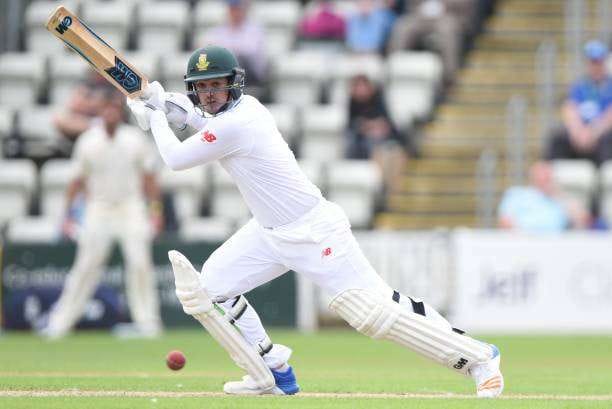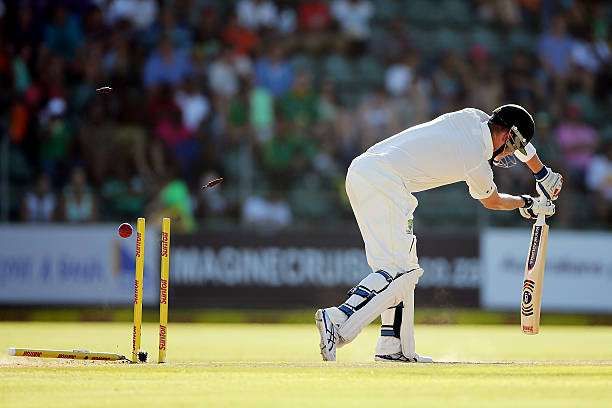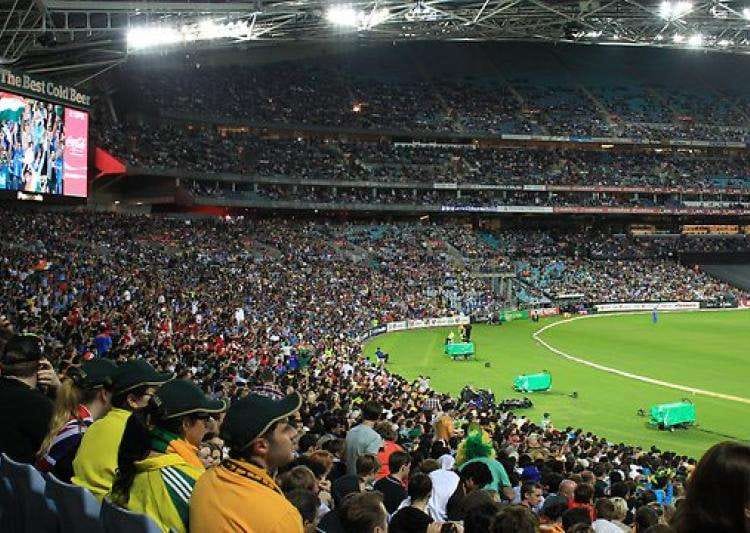You’ve been here a thousand times, a million times even. Your whole life is standing here, bracing for leather on willow. Every net, every game, everything in your life has been leading up to this point. Today you become a cricketer. You’re on foreign soil, an invader in a proud kingdom. You’re playing for your country, it’s the first game of your life. This is your moment. The crowd begins to clap and stomp and to the beat, a song plays in your mind:
“You better lose yourself in the music, the moment
You own it, you better never let it go”
You’re in this, you’re a hundred percent in this. The guy with the ball in his hand, he’s just a guy. This is your day. No one can take that away from you. You tap twice, with the beat of the crowd. It’s getting louder in here. He charges in, you’re ready for anything. It’s just you and him.
Whack!
*Thud*
What just happened? Blood kisses dirt. The song in your head is a shrill whine. You’re on your knees, scythed down by the rampaging bull with the crazy eyes. Your hands touch the dirt that betrayed you and your eyes, just moments earlier gleaming with anticipation, tear up. You’re in pain, but you know you can’t show it.
You’re in shock, you have no idea what just hit you. You don’t want to get up. You don’t want to face another. The crowd is baying for your head. This isn’t fair. Players gather around you. They’re the ones that hurt you. They’re the enemy, goddamn. Your partner on the front lines asks you if you can go on.
Through swimming eyes, you see the crest on his helmet. Your crest. You have to go on. With gritted teeth and a bloody nose, you pick yourself off the ground. Your gleaming whites now stained with brown and red; you take a deep breath. You go back to your mark, and they’re clapping. Not for him, not for them, but for you. Give me another. Give me a thousand more like them and I’ll play them all day. The song in your head blares at maximum volume, you’re back in this.
Welcome to Test cricket.
It’s Test cricket. Capital ‘T’. Don’t forget that. It is ‘Test’ cricket because it’s just that: a test. A test of skills, of character, of endurance and most of all, of determination. It is valuable and hard-earned. Only a privileged few have the opportunity of playing it. You need to be the best of the best of the best, and then some, to play for your country. Mark Nicholas, one of the finest observers of the game, once said, “If you are below standard in Test cricket, you are exposed like in no other sport.”
But that’s not true anymore, is it? In the heat of Chennai, in one of the biggest rivalries in cricket, Karun Nair plundered 303* off 381 balls. His other 6 test innings, all on tougher wickets, read: 4, 13, 26, 0, 23, 5. Karun Nair is a fantastic young talent, but was he a Test-quality batsman when he scored that 300? No. India dropped him from the team in the next game.
The reason he was allowed to join the elite triple centurion’s club had plenty to do with the fact that Liam Dawson, Moeen Ali, Jake Ball and Adil Rashid were hardly Test-quality bowlers, but also with the fact that the pitch was incredibly flat.
1443 runs were scored over 3 innings in that game, with just 27 wickets falling across the 5 days. High first and second innings scores were a characteristic of the entire series. Pitches did absolutely nothing for 3 days; both teams could virtually play ODI cricket, racking up 400, 500, 600 and even 700 plus scores. Then, by the time the pitch was as tired and worn as the eight people that turned up to watch these run-fests, it begins to turn, and players of both teams began to throw their wickets away. These sorts of pitches were not isolated to that series, but are a growing trend in Test cricket.
Since 1950, the 2010s and 2000s have been the best and second-best decades for batting in terms of batting average. There are several reasons for the uptake in scoring, with most of them having to do with a change of mentality towards pitches.
In the early 2000s, when boards began to cash in on the game, commercialising it like other mainstream sports, they realised that there was no place for the rank turner and the green seamer. Gradually, the lively pitches that made batsmen jump and duck and weave and miss disappeared, one by one.
In Australia (apart from the Gabba, bless you Kevin Mitchell Jr.) and in some grounds in New Zealand, drop-in pitches became popular in the early 2000s. As venues are used for other purposes, such as Australia’s AFL and New Zealand’s rugby games, pitches are carted in and out of venues. These ‘drop-in’ pitches are often extremely hard and flat, giving bowlers little outside the first hour of play, and very little when the weather is hot, as it usually is in Australia. Some pitches, like the SCG, have actually become more conducive to spin than to pace bowling.
Pakistan had to abandon the interesting pitches of Peshawar, Lahore and Karachi in favour of the flat wickets of the UAE in 2009. The PCB have no incentive to change the way the wickets at Dubai, Abu Dhabi and Sharjah play. Their team has never lost a series there since 2009, and the board has given up on bringing test cricket into the public’s consciousness, too strapped for cash and riddled with corruption to make a definitive change.
The West Indies’ pitches, where Andy Roberts, Michael Holding and Courtney Walsh used to dominate, have all inexplicably gone slow and low. Grounds made of alluvial soil, like Guyana and Dominica, have not been tended to carefully, leading to their becoming sluggish and boring, whereas grounds like Sabina Park and the Kensington Oval, where pitches are made of hard coral limestone, where pace has dominated for decades, are better, but still favour batting more than they did in the part. They have been relaid recently, but for the better part of the 21st century, every Caribbean cricket ground did little for bowlers until the fourth and fifth days, when they disintegrated quickly.
In England, the proliferation of Super Soppers and warmer weather has rendered surfaces far more dry and flat than in previous times (although England has not seen the sustained jump in batting average that other countries saw in the 2000s). South Africa has also seen an increase in scoring, but more often than not, pitches in South Africa are lively (with the exception of Newlands, which is often joked to be made of cement provided by its sponsor, PPC).
India and Sri Lanka saw grounds being made to suit their players. Having developed their batting by the 2000s, with the advent of Sangakkara, Jayawardene, Tendulkar and Dravid, they focused on making flat wickets that would begin to spin at the fag end of the games, when Kumble, Harbhajan, Muralitharan and Herath would run riot on the footmarks. This meant that India’s traditionally seaming wickets in the North, like Mohali and Kanpur, slowly fell to slow spin, and Sri Lanka’s venues, save for the rank turners they retain for when non-Asian teams tour, too, became very flat.
Life through the criss-cross grill is comfortable. Bat sponsors. Photoshoots. Recognition. Pride. Satisfaction. Articles in newspapers when you score, press-box formalities when you failed. The butterflies had stop fluttering when you walk out to bat. 40 tests does that to you. You hear a dull clapping as you enter and their echoes on empty seats. Time to complete the formalities: two high knees, a sideways hop or two, adjust the box, meet the partner, discuss their attack, bump gloves and go to the crease. 142-1.
The pitch is rolled and hard. Not even the suggestion of grass. Two taps, no beat this time to get in the rhythm. That’s fine. The guy limping in is weary under the weight of his figures. It’s a hot day, but you’re as cool as a cucumber. A song plays in your head, it does every time. Not hard rock, metal or rap, it’s a gentle tune. Serenity, calmness, you’re a ballet dancer. The ball floats in, the bounce is your friend. You don’t bother running. Tap bats, tap gloves, cheeky smile to the bowler.
You glance up at the press box, where childhood heroes and old teammates discuss your technique. “Classy”, they’ll say, amongst the sporting clichés and shallow analysis. The fire and brimstone with which you were raised is long gone. Hell, you can unleash your T20 shots if you want on this track. Dirt no longer betrays you. Only fans do. Empty stadia take off the pressure, take out the pleasure, but what can you do?
There are fewer draws in Test cricket nowadays. That’s good, right? Draws are boring. Not exactly. With more batsman showing poorer technique when the ball starts to spin or bounce unevenly on day 4, teams often force a result on the last day, after 3 or 4 days of excruciatingly boring accumulation. Plus, scoring rates have increased- a product of batsmen rotating the strike better than before. This doesn’t necessarily indicate a better viewing experience.
Higher scoring rates also indicate batsmen finding batting easy. They’re able to score quickly and comfortably because the pitch isn’t doing much. In fact, they can even hit through the line because there’s even bounce and not much lateral movement. People often credit T20 batting for this, but you cannot play T20 shots on tough pitches.
David Warner’s failures on spinning pitches or green seamers is proof of that. Batsmen, however, have become more adept at hitting quick bowling; match preparation for batsmen has advanced much faster than for bowlers. Consequently, games follow these rather boring templates:
First Innings, 400,
Second innings: 650,
Third Innings 200 all out
Or
1st Innings 550,
Second innings: 400,
Third Innings 200/3d,
Fourth Innings: 200 all out.
From May 2016 to May 2017, 14 Test matches followed this format. The ones that didn’t were often mismatches, like Sri Lanka in South Africa. A very low percentage of games allowed a fair contest between bat and ball. Since 2000, there has also been greater experimentation with grounds, with many new venues in the West Indies, Sri Lanka, the UAE and India. Groundsmen do not want to produce a ‘poor’ pitch and err on the safe (and boring) side, which leads to run-fests like Ranchi’s maiden Test earlier this year.
These high scoring Test matches are not fun for anyone. Not the players, not the spectators and not even cricket boards. Smaller nations (South Africa included) lose money when hosting Test games. On the other hand, low scoring games are often met with much larger public support. People longed to see the India-Australia game in Bangalore, even on the weekdays. The overall run rate during that game was less than 3, but that did not stop it from being a highly attended, highly entertaining, highly skilful contest.
Yet, administrators seem more than content with making pitches as flat as possible. Interesting pitches that lead to a result late on day four are called “below average”, while those that never see a fourth innings, due to a lack of overs rather than of wickets, are dubbed “good” by captains, commentators and match referees. And as a result, when curators throw up the odd rank turner (like Pune, 2017) or the odd greentop (Hobart, 2016), the both teams capitulate with a lack of game practice on tough wickets, and the wicket is rated ‘poor’ for being too tough to bat on.
In the last 10 years, five pitches have been rated either poor or unfit for being too tough to bat on, but just two were rated poor for being too easy to bat on. Furthermore, balls in recent times have been swinging around and seaming less and for shorter amounts of time, an issue boards are not exactly pouncing on to correct.
The obvious reasons is that administrators want games to go on for as long as possible. More days means more views. And more views, it means more money, right? But the problem is, pitches having become more flat means that there are far more boring Tests than interesting ones. Test cricket has a terrible reputation of being ‘unwatchable’ and ‘boring’. And it’s difficult to blame the casual fan for not wanting to watch the Rajkot, Mumbai or Chennai games of the England in India 2016 Test Series or the Ranchi game in the India Australia 2017 Test series.
How do you explain to someone who only watches the IPL that watching Pujara score 202 off 525 balls is an entertaining knock, especially when the pitch was doing nothing for the bowler. Where is the contest, when Tests become net practices until a declaration? Make interesting pitches with pace, bounce, zip, spin and seam, and watch. With a little time and a little marketing, the people will vote with their feet and eyes.
So why is nothing being done? Administrators have simply given up. In their scrambling for power and money, in their conflicts of interest and their greed, they have not tried hard or long enough to make Test cricket interesting. “Young people have no time for Tests.” has become a moniker for complacency.
Administrators are in a sort of deer-in-the-headlights type of paralysis, stuck in a strange limbo where they are holding more and more Tests, but not organising, marketing or managing them properly, haemorrhaging money in the process. They’re so stuck in the ways of old, too scared and useless to try chemotherapy to solve cricket’s cancer. Instead, they pump it full of morphine and try to manage its demise with dignity.
The solution is not in the past, but in the future. Make Tests into a lively contest, with spicy pitches. Anyone who would have seen a game on a difficult wicket would know it’s impossible to take your eyes off the action. Make games into a festival, inviting crowds to enjoy cricket like it is a fair. In the practice grounds near the stadium, food, drink, games and shows can be organised. Then pay the cricketers enough to stay. Promote local businesses.
When the Test carnival is in town, everyone will go to watch. If India were to host a Test in Mumbai on the same dates every year, it would become a part of the city’s culture. Look at the Boxing Day attendances in Australia, even for terrible, rain affected games. These ideas are not even tried by boards outside Australia, England and to an extent, South Africa.
Pitch doctoring is another issue the ICC has done little about. Home teams are free to make whatever pitches they want, so long as the match referee does not find it “poor”. This often means that teams in the subcontinent ‘make’ slow-turning roads, playing to their opponents’ weakness against spin. It also means that when India tours, teams make flat pitches to ensure games last all 5 days, a measure to gain maximum short-term TV revenues, while also appeasing a temperamental BCCI.
Fans and broadcasters alike are now optimistic about the Test League that the ICC is trying to implement. The league might bring more ICC regulation of pitch doctoring, which will be a breakthrough for the game, as long as the ICC begins to crack down on high scoring wickets.
It’s often said that Test cricket stands no chance in a world of smartphones and T20 leagues. On the contrary, it can thrive because of it. Test cricket’s epic scope allows people to have something to turn on their TVs to watch at all times. It’s the great constant in a world that is changing too fast for people to keep up. If held in the evenings, it’s a nightly TV series that matures, night after night. It’s a five day story, winding and unwinding before a dramatic finale, perfect for people of all ages. Watch it while you work, while you eat, but make sure you tune in.
In the documentary, Death of a Gentleman, cricket historian Gideon Haigh explains that there is little purpose to cricket without Test cricket. “I can’t see a lot of purpose to literature, if it’s only haiku. T20 needs something to be shorter than,” he says. The T20 revolution is impossible to ignore, but if Test cricket can find a way to appeal to a different need, a need to see fight and resilience instead of a hit and a giggle, it will always prosper alongside T20, not against it.
Where there was pimples and enthusiasm, there’s wrinkles and fatigue. Your red and white jersey is the order of the day, your team for a season, a means to an end. Oh, another wicket. Time to go bat. You lazily get out of your dug-out, do some half-hearted stretches and head to the pitch. Bright lights shine, Bollywood music plays and thousands of dancing people chant your name.
The announcer introduces you. He seems excited. The pyrotechnics are going crazy, you can barely hear yourself think but damn, you could get used to this. The pitch is flat, they all are in this country. You step up to your mark. This is why they pay you the big bucks. $100,000 for 30 minutes of slogging. You’re a hired gun, but know you love it. You take your guard, tap twice and give the crowd what they want- another DLF Maximum. Or what is Vivo? Pepsi? Who cares? This is the life.
What’s a 100 Tests when you can pay your mortgage with six weeks’ work?
It’s an often asked question: is sport entertainment or a pursuit of excellence? In an essay for The Cricket Monthly, Simon Barnes questions whether the point of sport is to satisfy the needs of the needs of the masses, or to seek the limits of human ability? Is sport manufactured entertainment or a display of the pinnacle of man’s physical capability, that just happens to be entertaining, he asks. Twenty20 has clearly made its choice, but have Tests? At this point in time, neither is it striving to be entertaining, nor is it an exhibition of excellence under difficult conditions.
Test cricket is gladiatorial combat, two men fighting tooth and nail at the doors of hell for survival, while the wild hounds of the fielding team sledge and hurl everything they have at them. They’re soldiers on the front line, dodging the enemy’s shells, they’re sailors braving a torrential storm. Test cricket is about our most primal instincts- rooting for an underdog. The men out there, they’re fighting for you, they’re fighting for their country.
Every country that plays test cricket was once a colony- the two men in the middle represent the dirty scrap for survival and freedom. It is cinema, it’s passion, it’s love, it’s patriotism. It’s joy, it’s sadness, it’s the endless human struggle- getting up when you’ve been kicked down, always fighting, keep pushing till the very end and this struggle deserves to be preserved.
Make Test cricket great again.
Follow IPL Auction 2025 Live Updates, News & Biddings at Sportskeeda. Get the fastest updates on Mega-Auction and cricket news






